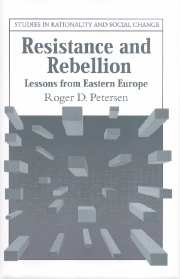Book contents
- Frontmatter
- Contents
- LIST OF FIGURES AND TABLES
- PREFACE
- 1 Introduction
- 2 Mechanisms and Process
- 3 Lithuania, 1940–1941
- 4 Rebellion in an Urban Community: The Role of Leadership and Centralization
- 5 The German Occupation of Lithuania
- 6 Postwar Lithuania
- 7 More Cases, More Comparisons
- 8 Resistance in the Perestroika Period
- 9 Fanatics and First Actors
- 10 Conclusions
- BIBLIOGRAPHY
- INDEX
8 - Resistance in the Perestroika Period
Published online by Cambridge University Press: 04 December 2009
- Frontmatter
- Contents
- LIST OF FIGURES AND TABLES
- PREFACE
- 1 Introduction
- 2 Mechanisms and Process
- 3 Lithuania, 1940–1941
- 4 Rebellion in an Urban Community: The Role of Leadership and Centralization
- 5 The German Occupation of Lithuania
- 6 Postwar Lithuania
- 7 More Cases, More Comparisons
- 8 Resistance in the Perestroika Period
- 9 Fanatics and First Actors
- 10 Conclusions
- BIBLIOGRAPHY
- INDEX
Summary
This chapter continues both the substantive and theoretical agendas of the book. Substantively, sections of this chapter and the next complete the history of Lithuanian anti-Soviet resistance (the events in Vilnius, Lithuania, in January 1991 are the subject matter of the following chapter). Theoretically, this chapter continues the process of applying the template of resistance mechanisms across new and expanded contexts. Here, the same template of mechanisms used previously is employed to investigate resistance in the perestroika period. Does this approach yield insights in a more modern time? Let us consider first what is to be explained.
Open anti-Soviet resistance resurfaced in the late perestroika period. It was not a violent rebellion involving community-based cells but rather took the form of mass rallies. This resistance was nonviolent, and loosely organized; individual participation meant moving from 0 to +1 on the spectrum. The essence of this participation was the same as in the 1940s: individuals accepting risk in resistance action against an opponent holding superior force. This chapter covers only a small part of the Eastern European “uprisings” of the late 1980s; the selection of cases rotates on the existence of clear risk in terms of personal safety and possible threats to jobs and careers. These conditions obtained in the USSR in 1987–1988 when the limits of glasnost were still untested and were present in Czechoslovakia, the German Democratic Republic, and Rumania in the fall of 1989.
- Type
- Chapter
- Information
- Resistance and RebellionLessons from Eastern Europe, pp. 236 - 271Publisher: Cambridge University PressPrint publication year: 2001

